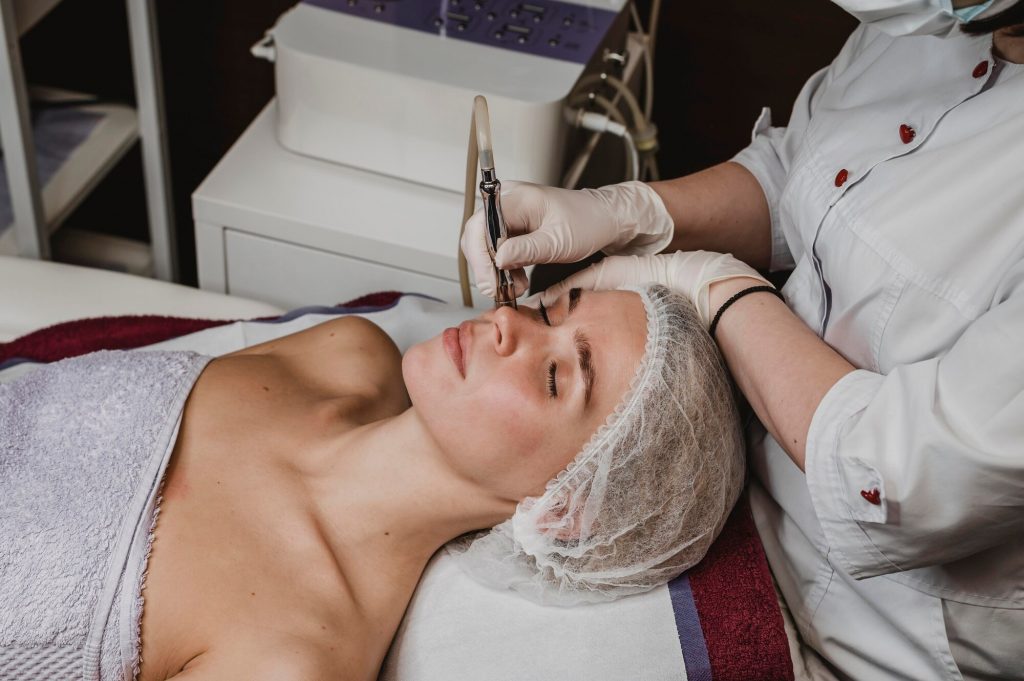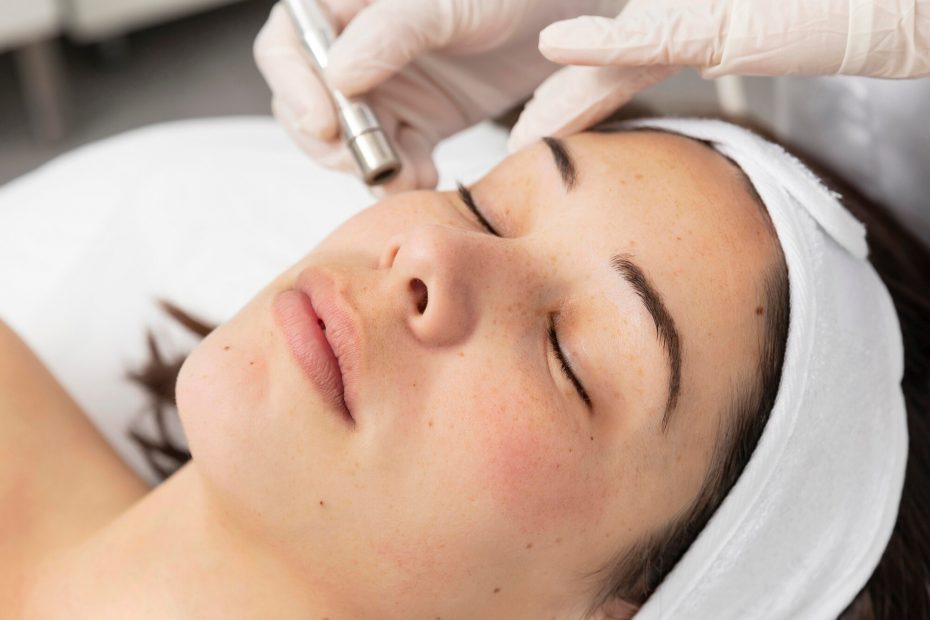
Everything You Need to Know About Microdermabrasion from a Medical Esthetician
By: Tanasa Tyler, Medical Esthetician
What is microdermabrasion, exactly?
Microdermabrasion is a non-invasive mechanical exfoliation cosmetic treatment. A handheld wand is used to gently exfoliate the stratum corneum layer of the epidermis-top layer of skin and remove dead skin cells. Minute diamond-studded tips or fine crystals are used on the skin while using a vacuum suction. It might feel a bit like sandpaper, but not for long.
Throughout the treatment, the pressure and speed of the vacuum can be adjusted to suit your skin tolerance and sensitivity. Microdermabrasion is not meant to cause pain — if it feels painful then your dermatologist or esthetician may be applying too much pressure. There is a cosmetic procedure called “dermabrasion” which is an invasive cosmetic procedure. It is tailored toward anyone with deeper acne scars and requires the use of anesthesia. This is not to be confused with microdermabrasion, as dermabrasion is usually performed by dermatologists or plastic surgeons.
What are the benefits of microdermabrasion?
- Skin becomes smoother and skin care products penetrate your skin better
- Helps improve the appearance of fine lines, sun damage, melasma, mild acne and superficial scarring
- Stimulates collagen production which aids in skin rejuvenation
- Brightens your complexion, produces an even skin tone and deep cleans your pores
“It has the benefit of limited downtime and risk. It can help brighten your skin temporarily. It may also improve dark spots and fine lines. It’s important to know that the results are very subtle and often require multiple or adjunctive treatments,” says University Langone Medical Centre dermatologist, Arielle Nagler.
What is done in preparation for microdermabrasion?
First your skin is cleansed. This is to ensure all of the dirt, debris and impurities are removed.
(A double cleanse is recommended.)
If using crystals, then they are gently sprayed along your skin while performing vertical and horizontal movements around your entire face. Two to three passes is usually enough.
If a diamond tip is being used, then the tip is attached to the hand piece and the machine is turned on. I recommend beginning at a low speed and gradually building up. Once the larger areas of your face are complete, forehead, cheeks and neck then the diamond tip is switched to a smaller diamond tip to exfoliate the smaller areas, eyebrows, under eyes, nose and around your lips.

A third cleanse can be done under steam and removed with a hot towel. (Which is what I like to do.) This ensures your skin is extra clean.
All necessary products are applied, tailored to your skin type and targeting your skin concerns. Be sure to seal everything in with sunscreen. Remember: your skin’s top layer has just been exfoliated, therefore it’s even more sensitive to sunlight.
“Any skin type can benefit from microdermabrasion. For people who are acne-prone, microdermabrasion can be used in combination with peels and medical extractions. Once that has been treated, they can go on to use retinoids like Differin Gel,” says dermatologic surgeon, Dendy Engelman.
Book your microdermabrasion appointment with us here.
A few side effects of microdermabrasion
- Minimal effects can occur such as short-term redness — the redness will subside within a few hours post-treatment
- Bruising, burning or tingling sensation and possibly some skin swelling may occur especially if you have very sensitive skin
- Your skin will have an increased sensitivity to sunlight
It is important to note that two weeks prior to treatment, it is recommended to stop the use of all retinoids and two weeks post-treatment. If you’ve taken the acne medication isotretinoin in the past six months, it is recommended to hold off on receiving microdermabrasion, as there can be a risk of scarring. It is best to consult with your dermatologist prior to this procedure.
Recovery time
Generally most people do not require much time to recover as most of the side effects dissipate after a few days. You may be ready for another treatment within one week; however, I suggest every 3-4 weeks.
The concept of abrading your skin dates as far back as 1500 BC when sand paper was used by Egyptian physicians to smooth out scars. Now this makes sense, hence the use of diamond tips and diamond crystals that feel like sand. Moving along to Germany in the 1900s, Kromayer used rotating wheels and rasps to remove the top layers of your skin. These were man-made, which was easily controlled, but not used often. It wasn’t until the 1950s when motorized wire brushes came about, however a number of problems arose with the use of dermabrasion:
- Immense pain — the procedure had to be performed using anesthesia
- It took two weeks for the top layers of your skin to heal
- Scarring often developed

Not only was the chance of infection high for the patient, but the practitioner and staff were also at risk, due to the exposure of abraded skin particles that were aerosolized.
Fast forward to Italy in 1985 — the first Microdermabrasion machine was developed by doctors Mattioli and Brutto, referred to as a “closed loop” system, in which the abraded skin was transferred to a “dirty” container once removed and was no longer aerosolized. This provided better safety for the practitioner and staff’s health. America was fully introduced to microdermabrasion machines in the 1990s and just erupted onto the scene. Today, there are over 100 different microdermabrasion machines on the market. They have been classified by Class 1 medical device by the FDA, which means:
1) Medical supervision is not required to operate, and
2) Demonstration of clinical efficacy is not needed and machines can be sold without any issues.
With the number of resurfacing cosmetic treatments out there, it’s nice to know that a treatment like microdermabrasion exists. As a Medical Esthetician, I find microdermabrasion to be quite an underrated treatment. While some people believe it doesn’t produce any “real” results, most likely because it’s non-invasive, it’s actually quite the opposite. Microdermabrasion is a fantastic cosmetic treatment! The key is to stick with it. Give yourself a little patience combined with the right products, and I truly believe you will be elated with the transformation of your skin. Not to mention it gives your skin the most gorgeous glow.
Microdermabrasion is a quick and painless cosmetic procedure, which I find relaxing, provides wonderful benefits for your skin and can achieve amazing results over time. Another reason why I love microdermabrasion is because it can be performed all over your body, providing the most satisfying look and feel. Definitely my favorite skin care treatment to perform and receive, I will always have it in my arsenal.
Schedule your microdermabrasion appointment with us today.
By: Tanasa Tyler, Medical Esthetician at the Rose Health Clinic
